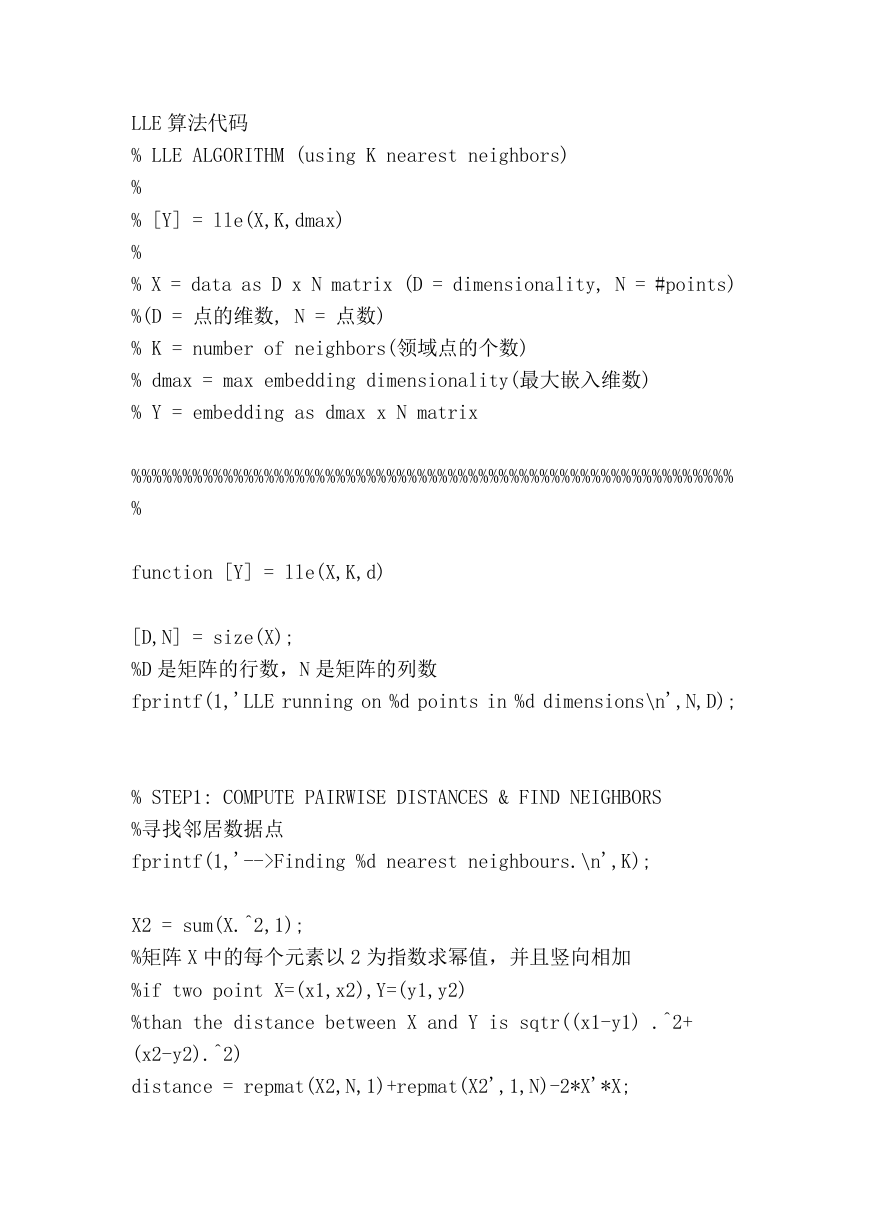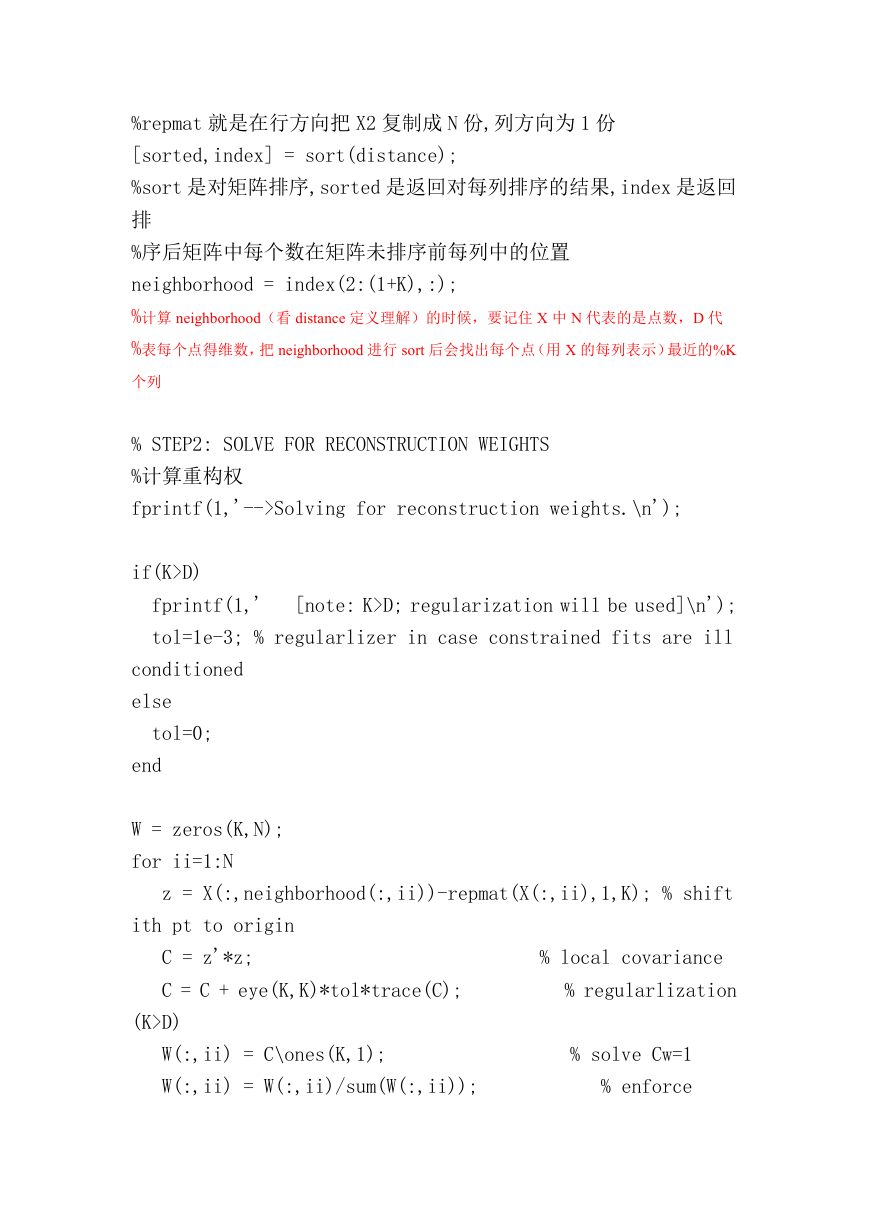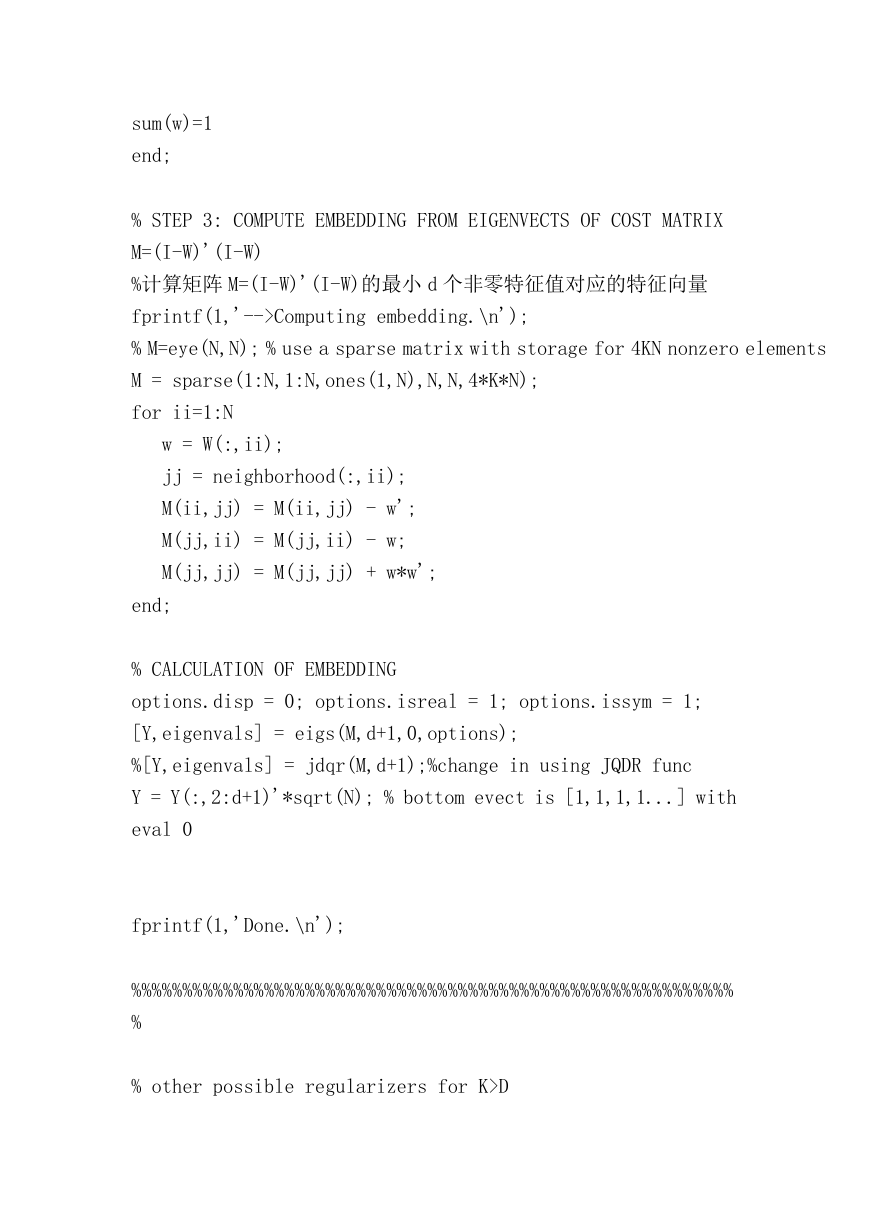LLE 算法代码
% LLE ALGORITHM (using K nearest neighbors)
%
% [Y] = lle(X,K,dmax)
%
% X = data as D x N matrix (D = dimensionality, N = #points)
%(D = 点的维数, N = 点数)
% K = number of neighbors(领域点的个数)
% dmax = max embedding dimensionality(最大嵌入维数)
% Y = embedding as dmax x N matrix
%%%%%%%%%%%%%%%%%%%%%%%%%%%%%%%%%%%%%%%%%%%%%%%%%%%%%%%%%%%
%
function [Y] = lle(X,K,d)
[D,N] = size(X);
%D 是矩阵的行数,N 是矩阵的列数
fprintf(1,'LLE running on %d points in %d dimensions\n',N,D);
% STEP1: COMPUTE PAIRWISE DISTANCES & FIND NEIGHBORS
%寻找邻居数据点
fprintf(1,'-->Finding %d nearest neighbours.\n',K);
X2 = sum(X.^2,1);
%矩阵 X 中的每个元素以 2 为指数求幂值,并且竖向相加
%if two point X=(x1,x2),Y=(y1,y2)
%than the distance between X and Y is sqtr((x1-y1) .^2+
(x2-y2).^2)
distance = repmat(X2,N,1)+repmat(X2',1,N)-2*X'*X;
�
%repmat 就是在行方向把 X2 复制成 N 份,列方向为 1 份
[sorted,index] = sort(distance);
%sort 是对矩阵排序,sorted 是返回对每列排序的结果,index 是返回
排
%序后矩阵中每个数在矩阵未排序前每列中的位置
neighborhood = index(2:(1+K),:);
%计算 neighborhood(看 distance 定义理解)的时候,要记住 X 中 N 代表的是点数,D 代
%表每个点得维数,把 neighborhood 进行 sort 后会找出每个点(用 X 的每列表示)最近的%K
个列
% STEP2: SOLVE FOR RECONSTRUCTION WEIGHTS
%计算重构权
fprintf(1,'-->Solving for reconstruction weights.\n');
if(K>D)
fprintf(1,'
[note: K>D; regularization will be used]\n');
tol=1e-3; % regularlizer in case constrained fits are ill
conditioned
else
tol=0;
end
W = zeros(K,N);
for ii=1:N
z = X(:,neighborhood(:,ii))-repmat(X(:,ii),1,K); % shift
ith pt to origin
C = z'*z;
% local covariance
C = C + eye(K,K)*tol*trace(C);
% regularlization
(K>D)
W(:,ii) = C\ones(K,1);
W(:,ii) = W(:,ii)/sum(W(:,ii));
% solve Cw=1
% enforce
�
sum(w)=1
end;
% STEP 3: COMPUTE EMBEDDING FROM EIGENVECTS OF COST MATRIX
M=(I-W)'(I-W)
%计算矩阵 M=(I-W)'(I-W)的最小 d 个非零特征值对应的特征向量
fprintf(1,'-->Computing embedding.\n');
% M=eye(N,N); % use a sparse matrix with storage for 4KN nonzero elements
M = sparse(1:N,1:N,ones(1,N),N,N,4*K*N);
for ii=1:N
w = W(:,ii);
jj = neighborhood(:,ii);
M(ii,jj) = M(ii,jj) - w';
M(jj,ii) = M(jj,ii) - w;
M(jj,jj) = M(jj,jj) + w*w';
end;
% CALCULATION OF EMBEDDING
options.disp = 0; options.isreal = 1; options.issym = 1;
[Y,eigenvals] = eigs(M,d+1,0,options);
%[Y,eigenvals] = jdqr(M,d+1);%change in using JQDR func
Y = Y(:,2:d+1)'*sqrt(N); % bottom evect is [1,1,1,1...] with
eval 0
fprintf(1,'Done.\n');
%%%%%%%%%%%%%%%%%%%%%%%%%%%%%%%%%%%%%%%%%%%%%%%%%%%%%%%%%%%
%
% other possible regularizers for K>D
�
%
C = C + tol*diag(diag(C));
regularlization
%
C = C + eye(K,K)*tol*trace(C)*K;
regularlization
%
%
�








 2023年江西萍乡中考道德与法治真题及答案.doc
2023年江西萍乡中考道德与法治真题及答案.doc 2012年重庆南川中考生物真题及答案.doc
2012年重庆南川中考生物真题及答案.doc 2013年江西师范大学地理学综合及文艺理论基础考研真题.doc
2013年江西师范大学地理学综合及文艺理论基础考研真题.doc 2020年四川甘孜小升初语文真题及答案I卷.doc
2020年四川甘孜小升初语文真题及答案I卷.doc 2020年注册岩土工程师专业基础考试真题及答案.doc
2020年注册岩土工程师专业基础考试真题及答案.doc 2023-2024学年福建省厦门市九年级上学期数学月考试题及答案.doc
2023-2024学年福建省厦门市九年级上学期数学月考试题及答案.doc 2021-2022学年辽宁省沈阳市大东区九年级上学期语文期末试题及答案.doc
2021-2022学年辽宁省沈阳市大东区九年级上学期语文期末试题及答案.doc 2022-2023学年北京东城区初三第一学期物理期末试卷及答案.doc
2022-2023学年北京东城区初三第一学期物理期末试卷及答案.doc 2018上半年江西教师资格初中地理学科知识与教学能力真题及答案.doc
2018上半年江西教师资格初中地理学科知识与教学能力真题及答案.doc 2012年河北国家公务员申论考试真题及答案-省级.doc
2012年河北国家公务员申论考试真题及答案-省级.doc 2020-2021学年江苏省扬州市江都区邵樊片九年级上学期数学第一次质量检测试题及答案.doc
2020-2021学年江苏省扬州市江都区邵樊片九年级上学期数学第一次质量检测试题及答案.doc 2022下半年黑龙江教师资格证中学综合素质真题及答案.doc
2022下半年黑龙江教师资格证中学综合素质真题及答案.doc